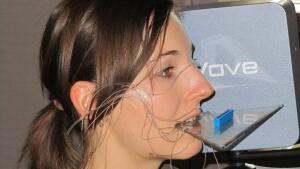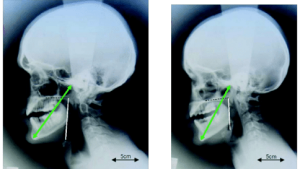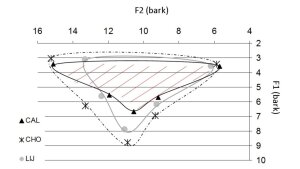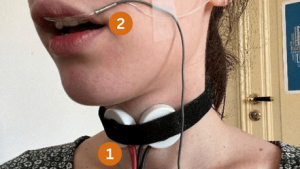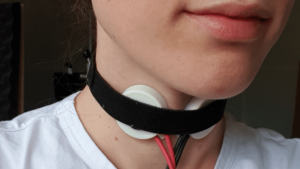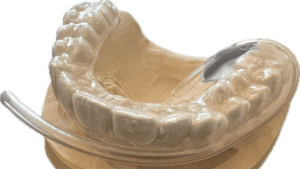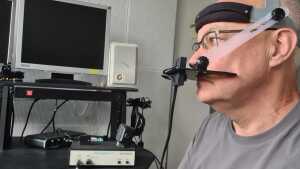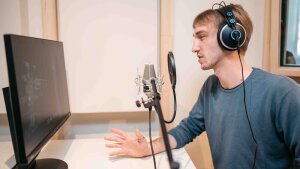Word cloud
Image: Fachbereich SprechwissenschaftWhat does our voice reveal about social identities? At the Department of Speech Science and Phonetics in Jena, we study spoken language systematically and interdisciplinarily - with a special focus on the social dimension of linguistic variation. Our research focuses on the interplay between voice, gender and social role as well as biological factors.
Our projects combine phonetic, linguistic and sociolinguistic perspectives, for example when we investigate how hormonal influences, professional contexts or cultural norms shape vocal expression. We ask questions such as: Do voices sound different during periods of hormonal upheaval? How do gender roles or professional contexts influence vocal characteristics? What linguistic expectations are placed on masculine and feminine voices - and how are they fulfilled or undermined?
In an interdisciplinary approach, we use acoustic, articulatory and perceptual analysis methods to empirically record linguistic variation. The JeCoP database forms the technical and methodological basis of many studies. With this special profile, Jena Phonetics has established itself as a central voice in German-speaking sociophonetics - and shows how language not only describes social reality, but also helps to shape it.
Word cloud
Image: Fachbereich SprechwissenschaftWhat does our voice reveal about social identities? At the Department of Speech Science and Phonetics in Jena, we study spoken language systematically and interdisciplinarily - with a particular focus on the social dimension of linguistic variation. Our research focuses on the interplay between voice, gender and social role as well as biological factors.
Our projects combine phonetic, linguistic and sociolinguistic perspectives, for example when we investigate how hormonal influences, professional contexts or cultural norms shape vocal expression. We ask questions such as: Do voices sound different during periods of hormonal upheaval? How do gender roles or professional contexts influence vocal characteristics? What linguistic expectations are placed on masculine and feminine voices - and how are they fulfilled or undermined?
In an interdisciplinary approach, we use acoustic, articulatory and perceptual analysis methods to empirically record linguistic variation. The JeCoP database forms the technical and methodological basis of many studies. With this special profile, Jena Phonetics has established itself as a central voice in German-speaking sociophonetics - and shows how language not only describes social reality, but also helps to shape it.
Research Projects on Gender and Sex
-
Language in Social Context
Frau spricht vor Menschen. Ihre Stimme formt die Kontexte der Personen.
Image: AI-generatedWho speaks how, when and why?
As part of the Heisenberg Professorship, this research project is dedicated to the interpretation of linguistic variability with the aim of analyzing the interplay of biological and social factors. Here we examine speaker-internal factors (anatomy and physiology, regional and social identity, hormones, choice of partner, communication goal/effect) and speaker-external parameters (professional environment, time, society, culture/language, situation, interlocutor).
-
Hormones and Voice
Schallwellen und Moleküle
Illustration: AI-generatedDo hormones resonate?
In this research project, we are looking at the influence of hormones on linguistic variability. Can you tell the testosterone level from the voice? Do women sound different during the fertile phase of their cycle? Do hormone levels have an influence on how voices are perceived?
To investigate these and similar questions, we created a corpus with voice, hormone and metadata from 30 men and 80 women. The hormone content in saliva was measured and correlated with vocal parameters such as average speaking pitch or voice quality.
-
Occupations and Voice
Learn more deLanguage and work: How does our environment influence the way we speak?
In this project, we are investigating whether our professional environment shapes the way we speak. To do this, we analyzed speech recordings of people from gender-typical professions, such as kindergartens and military barracks, as well as managers. Both read speech and spontaneous dialogues with colleagues were recorded.
-
Children’s Voices and Gender
View into a room. One side light blue - the other pink
Image: Adobe Stock / UnitedPhotoStudioCan you hear the gender of children?
Although girls' and boys' voices hardly differ anatomically and physiologically, adults are relatively accurate in recognizing the gender of children. In a long-term study, we are investigating which acoustic and perceptual characteristics play a role in this and how gender and gender conformity in children's voices develop over the primary school years.
-
Gender Representations on the Radio
An old radio on a sideboard
Image: pixabayDoes advertising reproduce gender stereotypes?
As advertising is dependent on generating both attention and approval in the shortest possible time, it often resorts to simplified and easily received representations. However, the question is to what extent these stereotypes really reflect the actual state of reality or merely use and reproduce outdated assumptions. The project therefore deals with the changing image of gender roles and the current discussion of the diversity of the concept of gender in the advertising context.
-
Parental Roles and Gender
Vater und Baby schauen ein Buch an
Image: Anne SiepchenIs there a difference in the way mothers and fathers speak to their children?
The project examines the relationship between gender-specific language and gender-specific roles (here: parental role). It examines the child-directed speech of German and Swedish mothers and fathers, as well as the possible influence of the parental role on adult-directed speech.
-
Articulation and Gender
Test subject with articular speech recording
Image: Lehrstuhl für Sprechwissenschaft und PhonetikDoes the voice of men and women differ only because of their anatomy?
Gender-specific differences in the way we speak have been known for many years. Studies over the last 50 years have shown that there are numerous acoustic and temporal differences in the way men and women speak. The extent to which these can be explained solely by anatomical and biophysical differences such as vocal tract size or vocal fold length, or whether they have a social component and are due to learned behavior, is often unclear.
-
Ethnicity and Gender
Hands form a circle
Image: pixabayHow do language, voice and appearance shape our impression of others?
This project investigates how we socially classify people based on their voice, accent or other characteristics. What role do gender, ethnicity and sexual orientation play in this? Using realistic stimuli, EEG measurements and interdisciplinary methods from psychology and phonetics, we analyze how expectations are formed, violated and adapted and what this reveals about social perception.
Selected studies from speech science on gender and sex
-
Occupations and personality
Learn more deSoldier and educator
Image: canvaDoes a voice sound friendlier just because it supposedly comes from an educator instead of a soldier? And do men with a high self-attribution of femininity really speak differently? A new study sheds light on how job descriptions, gender expression and voice shape our judgment of others - and surprises us with age-dependent effects.
-
Why do men mumble?
MRI image man and woman
Image: aus Weirich et al. 2016, JSLHRIs this due to social factors or to the anatomy?
Slurred speech or “mumbling” is a typical characteristic of male speech and can be the result of a small jaw opening. While on the one hand, behavioral reasons were used to explain gender-specific differences in clear speech, this study investigated anatomical factors to explain reduced jaw opening in men.
-
Speech tempo perception between men and women
Stopwatch with megaphone
Image: adobeStockWho speaks faster? Men or women?
Although the answer to this question is usually “WOMEN!”, empirical studies show the opposite: in a wide variety of languages, shorter durations and faster speaking speeds have been found for MEN.
One possible reason for the widespread opinion that women speak faster could be the influence of the size of the acoustic space within an utterance on the perceived speed. Women do not speak faster than men - they just sound that way!
-
A small articulatory space - a large acoustic space
Acoustic and articulatory vowel space in men and women
Image: Melanie WeirichWhy do some speakers seem faster or more slurred than others? A new study shows: Men are more likely to “undershoot” - they articulate sounds less completely. This can make speech seem faster, but also less clear. How our articulation style influences speech perception - and what this has to do with gender.
-
“Being a parent”, gender roles and language in Germany and Sweden
Self-assigned femininity of women and men in Germany and Sweden
Image: Melanie WeirichHow do gender roles, individual gender identity and parental responsibility influence the way we speak in everyday life? Studies from our department compare German and Swedish speakers and show that linguistic characteristics such as voice pitch and articulation are not only biological, but also strongly influenced by cultural norms, self-perception and social roles.
-
Child-directed language in Germany and Sweden
Christmas tree with presents
Illustration: Tu Anh Nguyen ThiWhat phonetic characteristics of child-directed speech do we find among mothers and fathers in Germany and Sweden? Is there an influence of involvement in childcare?
Whether in Germany or Sweden, parents use a higher pitch, more pitch variation and clearer vowels when speaking to their babies. This child-oriented language is evident across cultures, regardless of the parents' gender or childcare situation.
-
Women have a large vowel range and a high speaking voice pitch
Vowel spaces of three speakers
Image: aus Weirich & Simpson 2013, JASADo women have a larger acoustic vowel space to compensate for their higher speaking pitch?
Women have a larger acoustic vowel space than men. Their higher speaking pitch makes speech signals spectrally poorer, which they compensate for with clearer vowels. Our research investigates whether this correlation also exists within a gender group.
Research projects on other topics
-
Ejectives
Learn more deSensors of the electroglottograph (1) and the air pressure measuring device (2)
Image: Sprechwissenschaft und Phonetik JenaHow are ejectives formed - those consonants with complex articulatory movements that are phonologically anchored in some languages but only occur marginally in others? This dissertation project uses state-of-the-art methods such as electroglottography, air pressure measurement and MRI to investigate how these complex sounds are formed in Georgian and other languages. The focus is on fine articulatory mechanisms that have hardly been researched to date.
-
Dissertations
Learn more deDoktorhut auf Büchern
Image: Adobe StockThe Chair of Speech Science and Phonetics at the University of Jena is involved in a wide range of doctoral projects, including research into gender-specific language characteristics, regional language variations and the influence of the voice on teachers.
-
Bachelor theses
Learn more deJunge Menschen werfen Hüte in die Luft
Image: Adobe StockFrom child-directed speech to the voice of non-binary people, from testosterone to pitch in film and advertising - the Bachelor's theses at the Department of Speech Science and Phonetics show how diverse voice and language reflect social, biological and cultural aspects. Whether gender, emotion, language contact or counseling: the theses offer exciting insights into current research questions relating to speaking, hearing and understanding.
JeCoP – Jena Corpora of Phonetics
Monitor with data search mask
Illustration: AI-generatedJeCoP is a password-protected, browser-based and searchable database that provides audio recordings, orthographic and phonetic transcriptions as well as socio-demographic metadata of the speakers - such as gender, age, mother tongue or origin. It is based on the LaBB-Cat infrastructure (Fromont & Hay, 2012). Interested researchers can be granted access to the data and selected sub-corpora on request.
JeCoP is being continuously expanded and was initiated by Prof. Melanie Weirich (WE 5757/3) as part of Heisenberg funding. The database includes language materials (audio recordings as well as orthographic and phonetic annotations) and metadata collected in the course of various research projects at the Institute, for example on:
-
AVarE-Corpus
adult- and child-directed reading language of 70 German and Swedish mothers and fathers at four points in the child's first year of life (DFG project “Acoustic-phonetic variability in child- and adult-directed speech in parents during early childhood education de”, WE 5757/1, duration April 2016 to September 2019).
-
LoKiS-Corpus
Learn moreLongitudinal study of Kid's Speech. Long-term study with acoustic recordings (25 stimuli per child) of about 60 children aged six to ten years at four different points in time (DFG project “The acoustic and perceptual correlates of gender in children's voices”, SI 743/9-1/2, duration 2020-2027).
-
JobCo-Corpus
Reading language of speakers from traditionally male or female dominated occupational groups of the DFG project “Gender-specific phonetic variability: Hormonal influences and occupational environment de” (WE 5757/3 and WE5757/4, start November 2021).
-
HoCo-Corpus
Language data (held vowels, counting, reading language, picture description) from 30 men (18-28 years) and 80 women (18-45 years). Additional information on socio-demographic metadata and hormone levels (for men: testosterone and cortisol at three times of day; for women: Estradiol, progesterone and testosterone at two phases in the menstrual cycle). Collected within the DFG project “Gender-specific phonetic variability: hormonal influences and occupational environment de” (WE 5757/3 and WE5757/4, start November 2021).
Technical equipment
-
Ultrasound
Ultrasound
Image: Professur für SprechwissenschaftThe ultrasound device is an imaging technique that we use to analyze articulatory movements. We place the transducer under the subject's chin. The high-frequency sound waves are reflected at the interfaces between the tissue and the air, creating a visible image of the tongue contour during speech. In combination with acoustic recordings, the images provide us with valuable information.
-
Electroglottography (EGG)
Test subject with electrodes on the neck
Image: Fachbereich SprechwissenschaftThe EGG is a non-invasive measurement method that we use to analyze the vibrations of the vocal folds during speech. Two electrodes are attached to the side of the larynx and measure the electrical resistance, which changes as the vocal folds open and close. This produces a precise signal about the closure of the glottis. In combination with acoustic and articulatory data, the EGG provides detailed insights into vocal and speech motor processes.
-
Intraoral air pressure measurement
Palatal pressure measuring splint on a dental model
Image: Fachbereich SprechwissenschaftThe palatal pressure measuring splint is a customized device for measuring intraoral air pressure during speech. An integrated tube transmits the pressure from the oral cavity to an external measuring system. The splint is primarily used to analyze fricatives and plosives, as intraoral pressure plays a central role here. In a current project de, for example, we are using the system to compare plosives and ejectives. The precise pressure measurement provides important information on articulatory differences between sound types and language systems.
-
Nasometry
Man wears an apparatus on his head
Image: Fachbereich SprechwissenschaftNasometry is a non-invasive method for recording the nasal part of speech production. A special measuring mask is put on which isolates the oral and nasal airflow from each other using a separating plate. Microphones above and below the plate register the sound components from the nose and mouth separately. The ratio of these signals - the so-called nasalance - allows conclusions to be drawn about nasal resonance and velum function. Nasometry provides informative data on nasal involvement in speech, particularly for nasal sounds or in the investigation of velopharyngeal insufficiencies.
-
Language lab with recording studio
A man is speaking in a recording studio
Image: Fachbereich SprechwissenschaftThe speech laboratory of the Jena Department of Speech Science has a professionally equipped recording studio that is used for both scientific and artistic projects. The acoustically optimized environment enables high-quality speech and voice recordings - ideal for radio plays, audio books, speaking over images or speech science experiments. The exact reproducibility of the recording conditions makes it a valuable tool in experimental research.
The studio is also an important part of teaching. Students acquire practical skills in studio technology and acoustic analysis and carry out their own projects. The recording studio is available to members of the faculty on request. If you are interested in using the studio for research, teaching or artistic production, please contact de us.





